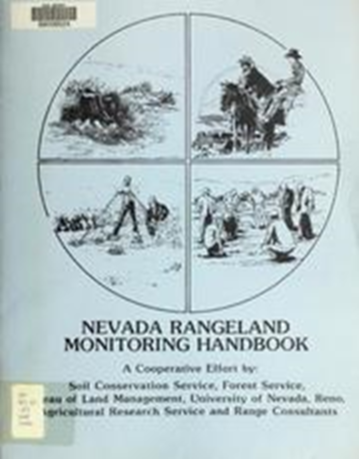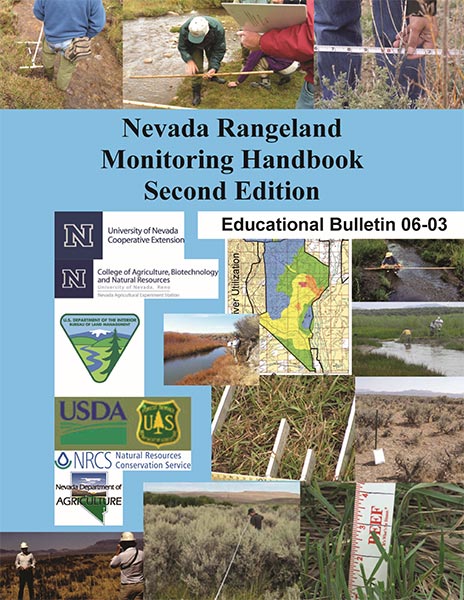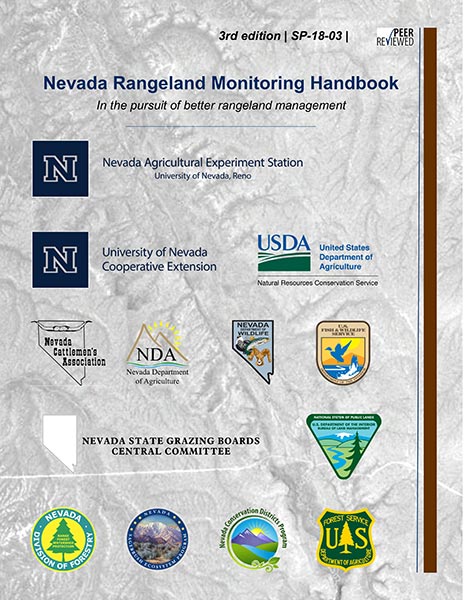The 1984 Nevada Rangeland Monitoring Handbook recommended long-term and short-term monitoring and the following studies to be conducted at key areas: 1) Production - The Natural Resources Conservation Service (NRCS) double sampling method and the Bureau of Land Management (BLM) weight estimate vegetation inventory method, 2) Quadrat frequency, and 3) The modified key forage plant utilization transect method. Production data were compared with NRCS ecological site descriptions to determine ecological status. Frequency was recommended to indicate changes in plant composition. These methods are still valid. The modified key forage plant method has been replaced by the key species method.
While the first Handbook proved useful, it was more than 20 years old when rewritten in 2006 to emphasize goals and objectives set in a planning process that considers the best available science and society's mix of values and expectations. Monitoring in the 1980s focused almost exclusively on livestock grazing management. By 2006 we recognized that, as important as this is, herbivory is only one aspect of rangeland management. Monitoring of vegetation change is also needed to track and manage problems such as modified fire regimes and invasive weeds that may not be resolved with changes in livestock management alone. Riparian issues were not addressed in the first handbook. We also had learned the importance of riparian assessment and monitoring for adjusting management.
At that time, production data were often interpreted differently as ecological site descriptions were being revised to reflect evolving ecological concepts. Production data (with functional group composition) compared with ecological site descriptions help determine ecological state and phase. This identifies pathways for management among phases to reduce risk and increase resiliency and resistance while avoiding expensive and risky challenges for restoration after transitioning across ecological thresholds. Species composition may be compared with desired plant community (DPC) objectives. Frequency studies emphasized nested plots to make data more useable through time as communities change. More commonly cover has become the measurement of choice.
The Nevada Sagebrush Ecosystem Council Monitoring Committee recognized the need for the third edition of this Monitoring Handbook to reconcile issues of scale from a focus on sage-grouse. Land management agencies have now committed to monitoring at various scales. The BLM Assessment, Inventory, and Monitoring (AIM) Strategy and the BLM-Forest Service (FS) Sage-grouse Monitoring Framework (USDI-BLM & USDA-FS 2014) included commitments to use the broad-, mid-, fine- and site-scale indicators of habitat suitability provided within the Sage-Grouse Habitat Assessment Framework (Stiver et al. 2015).
This Handbook addresses resource management and monitoring issues at the allotment scale, or smaller. The AIM strategy addresses resource issues and questions at scales larger than the individual allotment. Data collected for one or the other cannot stand alone to answer questions related to the other strategy. Data collected at specific locations for one approach however, may add value to data from the other approach. A random sampling of monitoring plots called for in AIM, may display the overall effects of a management paradigm, but random plots across a landscape may only occasionally occur in key areas tied to specific resource objectives. Plots will often occur in low-priority areas that are unlikely to change in response to management in a timely manner. The addition of random plots can eventually cause one to land on a key area. Managers must still choose the plot(s) suitable to inform adaptive management for specific objectives, and collect suitable short-term data to supplement long-term monitoring. Simply adding random plots may be too costly to sustain, and adding key area plots to a random array requires separate analysis.
Monitoring is a critical component of proper rangeland management. It is often required to ensure that management activities are being implemented and to document that the effects of management activities are achieving or moving resource conditions towards desired objectives and goals. However, funding and staffing to achieve this critical task are far too often insufficient and inadequate. This is true for governmental agencies and ranchers alike, and yet both must adequately fund and staff, and consistently complete essential monitoring. It is also necessary that monitoring be well planned to be efficient and effective.
Appropriate use of the Handbook assumes basic levels of professionalism, common sense, objectivity, education, experience and mentoring, and proper application of techniques. Every rangeland management and monitoring case is unique, depending on the initial conditions, site potential, objectives, level of management capabilities (economics, personnel, logistics, etc.), and the relationships among the participants. Where differences (real or imagined) among agency regulations, policy or guidance and the information provided in this handbook arise, the relevant regulation, policy or guidance will be used. However, it is intended that the Handbook and the Ranchers' Monitoring Guide meet and inform agency requirements.
Glossary – Terms hyperlinked to the glossary are blue.
Authors
- Sherman Swanson, University of Nevada Cooperative Extension (Editor in Chief)
- Brad Schultz, University of Nevada Cooperative Extension
- Patti Novak-Echenique, Natural Resources Conservation Service
- Kathryn Dyer, Bureau of Land Management
- Gary McCuin, Nevada Cattlemen's Association and Cooperative Extension
- James Linebaugh, Nevada State Grazing Boards
- Barry Perryman, Nevada Agricultural Experiment Station
- Paul Tueller, Rangeland Consultant
- Rixey Jenkins, Humboldt-Toiyabe National Forest
- Bettina Scherrer, Nevada Conservation Districts Program
- Tara Vogel, U. S. Fish and Wildlife Service
- David Voth, Nevada Department of Agriculture
- Mark Freese, Nevada Department of Wildlife
- Ryan Shane, Nevada Division of Forestry
- Kelly McGowan, Nevada Sagebrush Ecosystem Program
With special thanks to reviewers:
- Jeff White, Elko Land and Livestock Company
- Steve Abele and Justin Barrett, US Fish and Wildlife Service
- Gene Fults, Natural Resources Conservation Service
- And others
This handbook is also available as a PDF suitable for printing upon request. Contact Sherm Swanson, sswanson@cabnr.unr.edu, for more information, 775-784-4057.
 Nevada Rangeland Monitoring Handbook | First Edition
Nevada Rangeland Monitoring Handbook | First Edition
 Nevada Rangeland Monitoring Handbook | Second Edition
Nevada Rangeland Monitoring Handbook | Second Edition
 Nevada Rangeland Monitoring Handbook | Third Edition
Nevada Rangeland Monitoring Handbook | Third Edition


